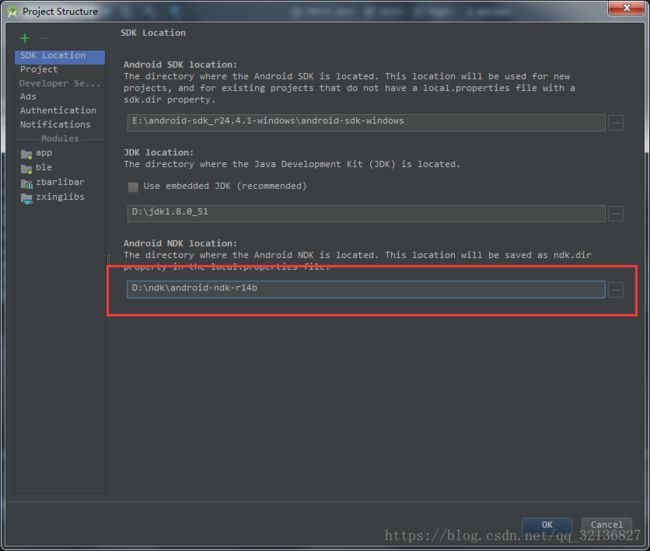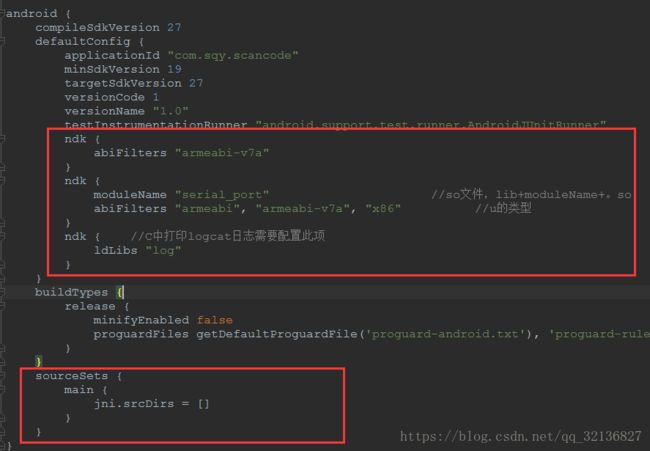Android 串口开发(一) 串口读写操作
开发串口程序首先要求你的设备需要支持串口通信,可以在设备上装一个App端的串口工具来检测一下
链接:https://pan.baidu.com/s/11L4aZI9orBhbnztka6H1Og
提取码:bvot
或者在电脑端下载一个友善串口助手检测一下,一般在Android工控主板上面都会带有串口。
首先我们是用到了谷歌开源的API serialPort
先贴出来下载地址 https://github.com/cepr/android-serialport-api
第一步 配置环境
1、开发工具Android studio,2.2-3.1.2都可以
2、配置NDK(http://blog.csdn.net/yehui928186846/article/details/52787773),网上教程很多,这里不做重点讲解,查看配置是否成功
3、Android studio配置ndk
二、用开源库代码复制到自己项目里
1、如下图所示
里面的操作类我做了重构,可能会跟开源里面的不一样,不过都是为了达到自己的需求嘛
2、配置build-gridle
配置信息直接粘上去就可以了
在project目录下的gradle.properties文件内加上
Android.useDeprecatedNdk=true这句话 ,为了兼容新老版本ndk3、类的讲解
public class SerialPortFinder {
public class Driver {
public Driver(String name, String root) {
mDriverName = name;
mDeviceRoot = root;
}
private String mDriverName;
private String mDeviceRoot;
Vector mDevices = null;
public Vector getDevices() {
if (mDevices == null) {
mDevices = new Vector();
File dev = new File("/dev");
File[] files = dev.listFiles();
int i;
for (i = 0; i < files.length; i++) {
if (files[i].getAbsolutePath().startsWith(mDeviceRoot)) {
Log.d(TAG, "Found new device: " + files[i]);
mDevices.add(files[i]);
}
}
}
return mDevices;
}
public String getName() {
return mDriverName;
}
}
private static final String TAG = "SerialPort";
private Vector mDrivers = null;
Vector getDrivers() throws IOException {
if (mDrivers == null) {
mDrivers = new Vector();
LineNumberReader r = new LineNumberReader(new FileReader("/proc/tty/drivers"));
String l;
while ((l = r.readLine()) != null) {
// Issue 3:
// Since driver name may contain spaces, we do not extract driver name with split()
String drivername = l.substring(0, 0x15).trim();
String[] w = l.split(" +");
if ((w.length >= 5) && (w[w.length - 1].equals("serial"))) {
Log.d(TAG, "Found new driver " + drivername + " on " + w[w.length - 4]);
mDrivers.add(new Driver(drivername, w[w.length - 4]));
}
}
r.close();
}
return mDrivers;
}
public String[] getAllDevices() {
Vector devices = new Vector();
// Parse each driver
Iterator itdriv;
try {
itdriv = getDrivers().iterator();
while (itdriv.hasNext()) {
Driver driver = itdriv.next();
Iterator itdev = driver.getDevices().iterator();
while (itdev.hasNext()) {
String device = itdev.next().getName();
String value = String.format("%s (%s)", device, driver.getName());
devices.add(value);
}
}
} catch (IOException e) {
e.printStackTrace();
}
return devices.toArray(new String[devices.size()]);
}
//获取设备上所有的串口节点
public String[] getAllDevicesPath() {
Vector devices = new Vector();
// Parse each driver
Iterator itdriv;
try {
itdriv = getDrivers().iterator();
while (itdriv.hasNext()) {
Driver driver = itdriv.next();
Iterator itdev = driver.getDevices().iterator();
while (itdev.hasNext()) {
String device = itdev.next().getAbsolutePath();
devices.add(device);
}
}
} catch (IOException e) {
e.printStackTrace();
}
return devices.toArray(new String[devices.size()]);
}
}
这个类一般不用,不占主要作用,主要用于可以获取设备上的所有可用的串口节点,用来选择设置,根据需求添加
public class SerialPort {
private static final String TAG = "SerialPort";
private FileDescriptor mFd;
private FileInputStream mFileInputStream;
private FileOutputStream mFileOutputStream;
public SerialPort(File device, int baudrate, int flags) throws SecurityException, IOException {
//检查访问权限,如果没有读写权限,进行文件操作,修改文件访问权限
if (!device.canRead() || !device.canWrite()) {
try {
//通过挂载到linux的方式,修改文件的操作权限
Process su = Runtime.getRuntime().exec("/system/bin/su");
String cmd = "chmod 777 " + device.getAbsolutePath() + "\n" + "exit\n";
su.getOutputStream().write(cmd.getBytes());
if ((su.waitFor() != 0) || !device.canRead() || !device.canWrite()) {
throw new SecurityException();
}
} catch (Exception e) {
e.printStackTrace();
throw new SecurityException();
}
}
mFd = open(device.getAbsolutePath(), baudrate, flags);
if (mFd == null) {
Log.e(TAG, "native open returns null");
throw new IOException();
}
mFileInputStream = new FileInputStream(mFd);
mFileOutputStream = new FileOutputStream(mFd);
}
// Getters and setters
public InputStream getInputStream() {
return mFileInputStream;
}
public OutputStream getOutputStream() {
return mFileOutputStream;
}
// JNI(调用java本地接口,实现串口的打开和关闭)
/**
* 串口有五个重要的参数:串口设备名,波特率,检验位,数据位,停止位
* 其中检验位一般默认位NONE,数据位一般默认为8,停止位默认为1
*/
/**
* @param path 串口设备的绝对路径
* @param baudrate 波特率
* @param flags 校验位
*/
private native static FileDescriptor open(String path, int baudrate, int flags);
public native void close();
static {//加载jni下的C文件库
System.loadLibrary("serial_port");
}
}这个SerialPort类是开源的,没有经过修改,Android可以,里面的直接调用,native方法直接和C通信,我们做Android的不需要管
jni目录下放着c源码和h头文件,
jniLibs下面放的就是so库。
注意:因为用的谷歌原生so库,所以SerialPort类的包名一定要是android_serialport_api,如果想修改这个包名,就需要重新生成对应的so库
public class SerialPortUtil {
public static String TAG = "SerialPortUtil";
/**
* 标记当前串口状态(true:打开,false:关闭)
**/
public static boolean isFlagSerial = false;
public static SerialPort serialPort = null;
public static InputStream inputStream = null;
public static OutputStream outputStream = null;
public static Thread receiveThread = null;
public static String strData = "";
public static Handler mHandler;
/**
* 打开串口
*/
public static boolean open() {
boolean isopen = false;
if(isFlagSerial){
LogUtils.e(TAG,"串口已经打开,打开失败");
return false;
}
try {
serialPort = new SerialPort(new File("/dev/ttyS3"), 115200, 0);
inputStream = serialPort.getInputStream();
outputStream = serialPort.getOutputStream();
receive();
isopen = true;
isFlagSerial = true;
} catch (IOException e) {
e.printStackTrace();
isopen = false;
}
return isopen;
}
/**
* 关闭串口
*/
public static boolean close() {
if(isFlagSerial){
LogUtils.e(TAG,"串口关闭失败");
return false;
}
boolean isClose = false;
LogUtils.e(TAG, "关闭串口");
try {
if (inputStream != null) {
inputStream.close();
}
if (outputStream != null) {
outputStream.close();
}
isClose = true;
isFlagSerial = false;//关闭串口时,连接状态标记为false
} catch (IOException e) {
e.printStackTrace();
isClose = false;
}
return isClose;
}
/**
* 发送串口指令
*/
public static void sendString(String data, Handler handler) {
mHandler = handler;
if (!isFlagSerial) {
LogUtils.e(TAG, "串口未打开,发送失败" + data);
return;
}
try {
outputStream.write(ByteUtil.hex2byte(data));
outputStream.flush();
LogUtils.e(TAG, "sendSerialData:" + data);
} catch (IOException e) {
e.printStackTrace();
LogUtils.e(TAG, "发送指令出现异常");
}
}
/**
* 接收串口数据的方法
*/
public static void receive() {
if (receiveThread != null && !isFlagSerial) {
return;
}
receiveThread = new Thread() {
@Override
public void run() {
while (isFlagSerial) {
try {
byte[] readData = new byte[32];
if (inputStream == null) {
return;
}
int size = inputStream.read(readData);
if (size > 0 && isFlagSerial) {
strData = ByteUtil.byteToStr(readData, size);
LogUtils.e(TAG, "readSerialData:" + strData);
}
} catch (IOException e) {
e.printStackTrace();
}
}
}
};
receiveThread.start();
}
}这个类就比较重要了,打开串口、关闭串口、读写操作,都在这个类里面写了详细的注释,另外下面在贴一个工具类出来
package com.sqy.scancode.util;
import android.graphics.Bitmap;
import android.graphics.BitmapFactory;
import android.util.Base64;
import java.io.FileInputStream;
import java.io.IOException;
import java.io.InputStream;
import Decoder.BASE64Decoder;
import Decoder.BASE64Encoder;
/**
* Created by Administrator on 2018/6/15.
*/
public class ByteUtil {
/**
* 字符串转化成为16进制字符串
*
* @param s
* @return
*/
public static String strTo16(String s) {
String str = "";
for (int i = 0; i < s.length(); i++) {
int ch = (int) s.charAt(i);
String s4 = Integer.toHexString(ch);
str = str + s4;
}
return str;
}
/**
* 16进制转换成为string类型字符串
*
* @param s
* @return
*/
public static String hexStringToString(String s) {
if (s == null || s.equals("")) {
return null;
}
s = s.replace(" ", "");
byte[] baKeyword = new byte[s.length() / 2];
for (int i = 0; i < baKeyword.length; i++) {
try {
baKeyword[i] = (byte) (0xff & Integer.parseInt(s.substring(i * 2, i * 2 + 2), 16));
} catch (Exception e) {
e.printStackTrace();
}
}
try {
s = new String(baKeyword, "UTF-8");
new String();
} catch (Exception e1) {
e1.printStackTrace();
}
return s;
}
/**
* 向串口发送数据转为字节数组
*/
public static byte[] hex2byte(String hex) {
String digital = "0123456789ABCDEF";
String hex1 = hex.replace(" ", "");
char[] hex2char = hex1.toCharArray();
byte[] bytes = new byte[hex1.length() / 2];
byte temp;
for (int p = 0; p < bytes.length; p++) {
temp = (byte) (digital.indexOf(hex2char[2 * p]) * 16);
temp += digital.indexOf(hex2char[2 * p + 1]);
bytes[p] = (byte) (temp & 0xff);
}
return bytes;
}
/**
* 接收到的字节数组转换16进制字符串
*/
public static String bytes2HexString(byte[] b, int size) {
String ret = "";
for (int i = 0; i < size; i++) {
String hex = Integer.toHexString(b[i] & 0xFF);
if (hex.length() == 1) {
hex = '0' + hex;
}
ret += hex.toUpperCase();
}
return ret;
}
public static String bytesToHexString(byte[] src) {
StringBuilder stringBuilder = new StringBuilder("");
if (src == null || src.length <= 0) {
return null;
}
for (int i = 0; i < src.length; i++) {
int v = src[i] & 0xFF;
String hv = Integer.toHexString(v);
if (hv.length() < 2) {
stringBuilder.append(0);
}
stringBuilder.append(hv);
}
return stringBuilder.toString();
}
/**
* 接收到的字节数组转换16进制字符串
*/
public static String byteToStr(byte[] b, int size) {
String ret = "";
for (int i = 0; i < size; i++) {
String hex = Integer.toHexString(b[i] & 0xFF);
if (hex.length() == 1) {
hex = '0' + hex;
}
ret += hex.toUpperCase();
}
return ret;
}
/**
* BASE64码解密成图片
*/
public static Bitmap Base64ToImage(String imgStr) { // 对字节数组字符串进行Base64解码并生成图片
BASE64Decoder decoder = new BASE64Decoder();
Bitmap bitmap = null;
try {
// Base64解码
byte[] b = decoder.decodeBuffer(imgStr);
for (int i = 0; i < b.length; ++i) {
if (b[i] < 0) {// 调整异常数据
b[i] += 256;
}
}
bitmap = BitmapFactory.decodeByteArray(b,0,b.length);
return bitmap;
} catch (Exception e) {
LogUtils.e("TAG","解析异常");
return bitmap;
}
}
/**
* 将图片转换为base64加密数据
*/
public static String ImageToBase64(String imgFile) {
InputStream in = null;
byte[] data = null;
try {
in = new FileInputStream(imgFile);
data = new byte[in.available()];
in.read(data);
in.close();
} catch (IOException e) {
LogUtils.e("TAG","加密异常");
e.printStackTrace();
}
BASE64Encoder encoder = new BASE64Encoder();
return encoder.encode(data);
}
/**
* 计算CRC16校验码
* 逐个求和
*
* @param bytes 字节数组
* @return {@link String} 校验码
* @since 1.0
*/
public static String getCRC_16(byte[] bytes) {
int CRC = 0x0000ffff;
int POLYNOMIAL = 0x0000a001;
int i, j;
for (i = 0; i < bytes.length; i++) {
CRC ^= ((int) bytes[i] & 0x000000ff);
for (j = 0; j < 8; j++) {
if ((CRC & 0x00000001) != 0) {
CRC >>= 1;
CRC ^= POLYNOMIAL;
} else {
CRC >>= 1;
}
}
}
if (Integer.toHexString(CRC).toUpperCase().length() == 2) {
return byteToStr(bytes, bytes.length) + "00" + Integer.toHexString(CRC).toUpperCase();
} else if (Integer.toHexString(CRC).toUpperCase().length() == 3) {
return byteToStr(bytes, bytes.length) + "0" + Integer.toHexString(CRC).toUpperCase();
}
return byteToStr(bytes, bytes.length) + Integer.toHexString(CRC).toUpperCase();
}
/**
* 指令校验和,并取出后两位字节
* */
public static String getSum16(byte[] msg, int length) {
long mSum = 0;
byte[] mByte = new byte[length];
/** 逐Byte添加位数和 */
for (byte byteMsg : msg) {
long mNum = ((long) byteMsg >= 0) ? (long) byteMsg : ((long) byteMsg + 256);
mSum += mNum;
} /** end of for (byte byteMsg : msg) */
/** 位数和转化为Byte数组 */
for (int liv_Count = 0; liv_Count < length; liv_Count++) {
mByte[length - liv_Count - 1] = (byte) (mSum >> (liv_Count * 8) & 0xff);
} /** end of for (int liv_Count = 0; liv_Count < length; liv_Count++) */
return byteToStr(msg, length) + byteToStr(mByte, mByte.length).substring(byteToStr(mByte, mByte.length).length() - 4, byteToStr(mByte, mByte.length).length());
}
}4、demo下载地址 : https://github.com/z-jc/ScanCode 里面可能还会有一些别的功能,需要的话自行下载
5、另外再提供一个自己封装好的module,https://github.com/z-jc/SerialProject-master,app导入module
然后在activity内直接这样调用
省心又省劲是不是,用到串口的项目可以直接当一个libray导入项目,不过需要检验的话还是得根据自己的校验方法来进行校验
以上全为原创,如有讲解不到之处,还请广大朋友指点一下
下一篇 Android 串口开发(二) 支持设置奇偶校验、数据位、停止位





